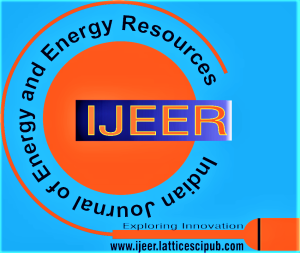Efficiency Improvement and Comparative Studies of Solar Organic Rankine Systems using Nanofluids
Raghav. S1, Karthik. D2, Nithin. K3, Badarinarayana. K4
1Raghav Sarathy, Department of Mechanical Engineering, RV College of Engineering, Bangalore (Karnataka), India.
2Dr. Badarinarayana K, Professor, RV College of Engineering, Bangalore (Karnataka), India.
3Karthik Dilipan, Department of Mechanical Engineering, RV College of Engineering, Bangalore (Karnataka), India.
4Nithin Krishnappa, Department of Mechanical Engineering, RV College of Engineering, Bangalore (Karnataka), India.
Manuscript received on 28 September 2022 | Revised Manuscript received on 08 October 2022 | Manuscript Accepted on 15 November 2022 | Manuscript published on 30 November 2022 | PP: 1-9 | Volume-2 Issue-1, November 2022. | Retrieval Number: 100.1/ijeer.A1020112122 | DOI: 10.54105/ijeer.A1020.112122
Open Access | Ethics and Policies | Cite | Mendeley | Indexing and Abstracting
© The Authors. Published by Lattice Science Publication (LSP). This is an open-access article under the CC-BY-NC-ND license (http://creativecommons.org/licenses/by-nc-nd/4.0/)
Abstract: Solar power generation has emerged as one of the most rapidly growing sources of renewable energy. The solar thermal system with a Rankine cycle used to harness solar energy and generate electricity from a low-temperature heat source is an emerging technology. The major drawback of solar thermal power generation is its poor efficiency, which is around 10% to 15%. Although prior attempts to improve the efficiency of the solar thermal system and use of Nano fluids in heat transfer applications have been carried out, very little work has been carried out using Nano fluids in Rankine cycle systems. Thus, the objective of the research undertaken was to primarily improve the efficiency of a small-scale solar thermal system by selecting working fluids, optimizing the system parameters and using Nano fluids with improved heat transfer properties for capturing heat. Thermodynamic simulation tool Aspen Hysys was used to carry out simulations of the Rankine and Regenerative Rankine systems. The system was simulated with combinations of Dowtherm-Cu O/Ag/Al2O3/TiO2 as the heat transfer fluid, and n-butane, n-pentane, n-hexane, or R-134a as the working fluid. System parameters such as mass flow, temperature, and pressure were optimized to obtain maximum power output and efficiency, keeping the system constraints and practicality in mind. The use of Nano fluids improved heat transfer to the working fluid in the heat exchanger by a maximum of 50%. The efficiency of the basic Rankine cycle was determined 16.03% for n-pentane, 14.90% for n-hexane, 13.83% for n-butane, and 9.82% for R-134a as the working fluid. Further, the use of regeneration improved the efficiency of the system by 6%, 3 %, 7% and 2% respectively. Highest efficiency of 27.96% was obtained when 6% volume concentration of Al2O3 was used in the heat transfer fluid, and n-pentane was used as the working fluid in the Regenerative Rankine cycle.
Keywords: Solar Organic Rankine Cycle, Nano-fluids, Heat Transfer, Simulation, Optimization, Aspen Hysys.
Scope of the Article: Renewable (Biomass, Hydro Power, Geothermal, Solar, Wind)
